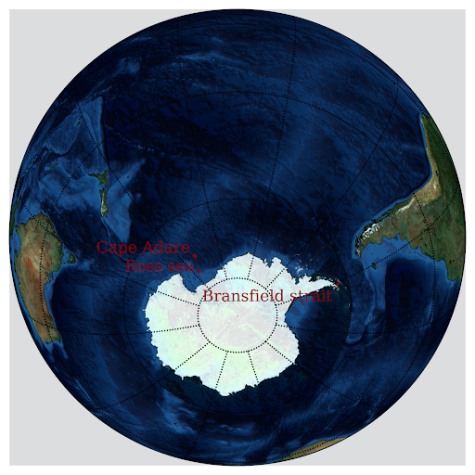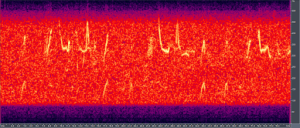Mysteries, Oddities, and Everything Strange: The Bloop
December 16, 2022
The Bloop: A Spectacular Underwater Beast
The ocean is a pretty terrifying place. Venturing too far into the sea while swimming can instill terror into the strongest of swimmers, so the deep sea with thousands of feet of open water beneath is quite horrific. Most of the ocean has been left unexplored by humanity, so the mysteries of the open sea have been left relatively untouched. The giant squid? The megalodon? The mermaid? These creatures and more could possibly be found out on the open ocean if humanity searched far enough. One of the most mysterious discoveries from the deep sea has puzzled scientists and oceanographers for years, and could possibly lead to the discovery of one of the largest underwater discoveries in decades.
 The bloop is the name of a strange and undiscovered sound that was recorded in the ocean in 1997. Researchers were attempting to find any traces of volcanic activity or animal migration near Antarctica when a strange noise caught them off guard. Unexplainably loud and occurring multiple times, the microphones placed all throughout the southern Pacific recorded the mysterious noise. The sound sounds exactly like its name, as a small bloop occurs in between the natural noises of the ocean. It occurred roughly at the southern tip of South America by an oceanic Sound Surveillance System known as the Equatorial Pacific Ocean autonomous hydrophone array. The sound was recorded over a range of 5,000 km and picked up by every device in the area. Normally, sounds are not powerful enough to span such a large range, so this event sparked the interest of scientists, marine biologists, and other ocean experts.
The bloop is the name of a strange and undiscovered sound that was recorded in the ocean in 1997. Researchers were attempting to find any traces of volcanic activity or animal migration near Antarctica when a strange noise caught them off guard. Unexplainably loud and occurring multiple times, the microphones placed all throughout the southern Pacific recorded the mysterious noise. The sound sounds exactly like its name, as a small bloop occurs in between the natural noises of the ocean. It occurred roughly at the southern tip of South America by an oceanic Sound Surveillance System known as the Equatorial Pacific Ocean autonomous hydrophone array. The sound was recorded over a range of 5,000 km and picked up by every device in the area. Normally, sounds are not powerful enough to span such a large range, so this event sparked the interest of scientists, marine biologists, and other ocean experts.
Some of the first theorists who discovered this phenomenon jumped to the possibility of a massive animal. Christopher Fox at the National Ocean and Atmospheric Administration (NOAA) claimed that the noise could possibly have been derived from an animal cry stronger than any other discovered animal on Earth at the time. The nature of the sound, especially its variations in frequency, would mimic that of documented sea creatures, according to Fox. This assumption led Fox to theorize that there was a new, undiscovered sea monster that was bigger than the largest whales and could make a noise detectable over 3,000 miles away. Some even theorized that the monster could be H. P. Lovecraft’s Cthulhu, a giant sea beast that emerged not far away from where the sound was recorded in Lovecraft’s Call of Cthulhu.
 Despite the intrigue that comes with a mysterious and gigantic undiscovered animal, the real solution to the bloop is more disappointing—the noise is more than likely the result of a cryoseism, or an icequake. An icequake occurs when a part of an antarctic glacier breaks off and drifts away from the main formation. The iceberg that generated this massive sound existed in the most southern regions of the Pacific Ocean near Antarctica, spanning from the tip of South America to the international date line. The Bransfield Strait, Drake Passage, Ross Sea, and Cape Adare are all viable contenders for the location of the bloop’s collapse. From 2005 to 2010, countless surveys were conducted in said areas, and countless icequakes were recorded. These natural phenomena are the most common source of natural noise in the southern reaches of the world. The sound is similar to thunder when played at normal speed, as most renditions speed it up by about 16 times.
Despite the intrigue that comes with a mysterious and gigantic undiscovered animal, the real solution to the bloop is more disappointing—the noise is more than likely the result of a cryoseism, or an icequake. An icequake occurs when a part of an antarctic glacier breaks off and drifts away from the main formation. The iceberg that generated this massive sound existed in the most southern regions of the Pacific Ocean near Antarctica, spanning from the tip of South America to the international date line. The Bransfield Strait, Drake Passage, Ross Sea, and Cape Adare are all viable contenders for the location of the bloop’s collapse. From 2005 to 2010, countless surveys were conducted in said areas, and countless icequakes were recorded. These natural phenomena are the most common source of natural noise in the southern reaches of the world. The sound is similar to thunder when played at normal speed, as most renditions speed it up by about 16 times.
The reason for these icequakes comes from the pressing issue we all know and hate: global warming. Icequakes are becoming all too common as excessive heat is causing gigantic hunks of ice to separate from glaciers and collapse into the ocean. Not to beat a dead horse, but global warming is one of the most important issues of modern times, and something must be done about this before the Earth is completely void of all glaciers. The bloop might not be a grand and terrifying animal, but it can be a wake up call to humanity to fix its broken ways and find a solution to the planet’s destruction.
Resources:
https://en.wikipedia.org/wiki/Bloop













































